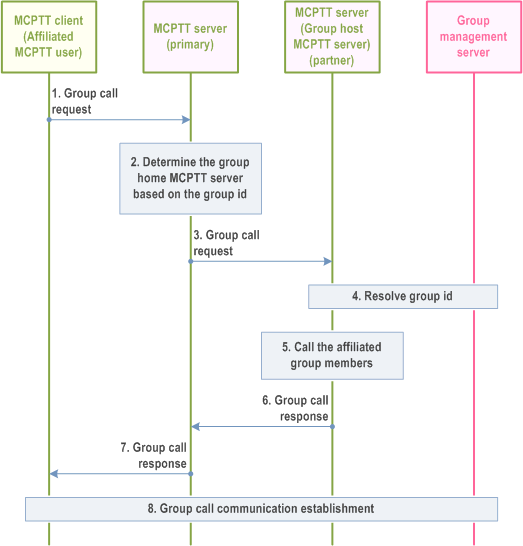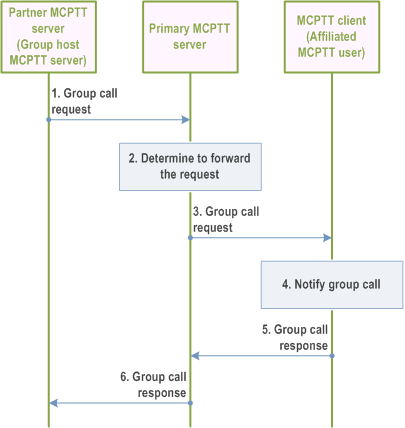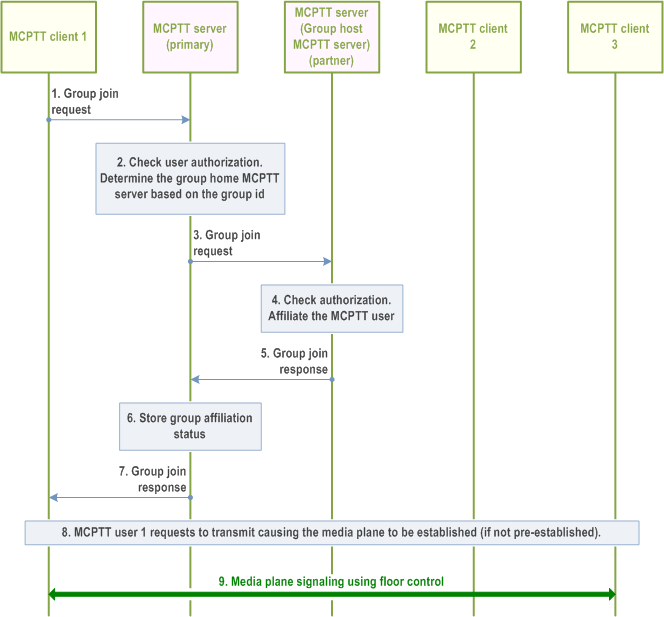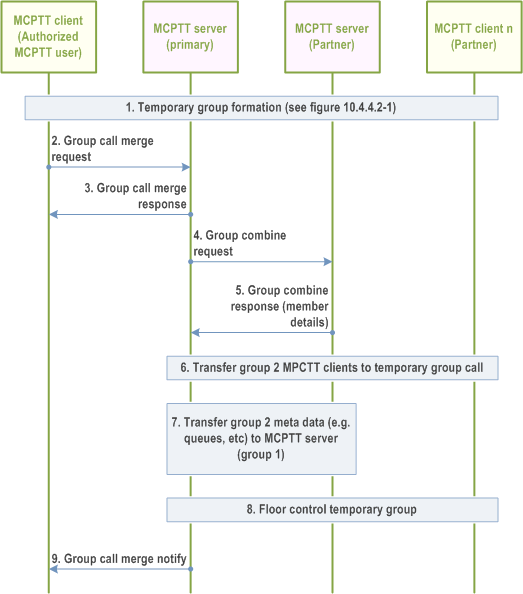Content for TS 23.379 Word version: 19.3.0
1…
7…
7.4…
10…
10.5…
10.6…
10.6.2.2.13…
10.6.2.2.24…
10.6.2.3…
10.6.2.3.1.2…
10.6.2.3.2…
10.6.2.4…
10.6.2.4.3…
10.6.2.5…
10.6.2.5.2.3…
10.6.2.6…
10.6.2.6.2…
10.6.2.7…
10.6.2.10…
10.6.3…
10.7…
10.7.2.2…
10.7.2.3…
10.7.3…
10.7.4…
10.7.5…
10.7.5.2.3a…
10.7.6…
10.7.6.2.3…
10.9…
10.9.1.3…
10.9.1.3.2…
10.9.1.3.3…
10.9.1.4…
10.9.1.5…
10.9.2…
10.9.2.6…
10.10…
10.12…
10.14…
10.15…
10.19…
10.19.2.11…
10.19.3…
10.19.3.1.4…
10.19.3.2…
10.19.3.2.4…
10.19.3.2.6…
A…
A.4…
B…
10.6.2.4.3 Group call for an MCPTT group defined in the partner MCPTT system
10.6.2.4.3.1 Pre-arranged group call setup procedure - initiating side
10.6.2.4.3.2 Pre-arranged group call setup - terminating side
10.6.2.4.3.3 Chat group call setup
10.6.2.4.4 Merging of groups involving multiple MCPTT systems
...
...
10.6.2.4.3 Group call for an MCPTT group defined in the partner MCPTT system p. 69
10.6.2.4.3.1 Pre-arranged group call setup procedure - initiating side p. 69
Figure 10.6.2.4.3.1-1 illustrates the pre-arranged group call setup procedure for an MCPTT group defined in the partner MCPTT system.
Pre-conditions:
- MCPTT group is defined on the group management server which is located in the partner MCPTT system with MCPTT users affiliated to that group.
- The members of the MCPTT group defined in partner MCPTT system belong to different MCPTT systems.

Step 1.
The affiliated MCPTT user via MCPTT client initiates a group call with an MCPTT group ID. A group call request message with the MCPTT group ID is routed to the MCPTT server of the primary MCPTT system.
Step 2.
The MCPTT server of the primary MCPTT system determines the group home MCPTT server where the MCPTT group is defined.
Step 3.
The MCPTT server of the primary MCPTT system forwards the group call request to the MCPTT server of the partner MCPTT system which owns the group and is where the authorized MCPTT user/dispatcher created the temporary group.
Step 4.
The MCPTT server of the partner MCPTT system checks whether the user of MCPTT client is authorized for initiating the group call for the selected group. If authorized, it resolves the MCPTT group ID to determine the members of that group and their affiliation status, based on the information from group management server.
Step 5.
The MCPTT server of the partner MCPTT system initiates a call request to the group's affiliated members.
Step 6.
The MCPTT server of the partner MCPTT system provides a group call response message to the MCPTT server of the primary MCPTT system of the MCPTT client. The group call response message will consist of the success or failure result and/or detailed reason information if there is a failure.
Step 7.
The MCPTT server of the primary MCPTT system forwards the group call response message to the MCPTT client.
Step 8.
Upon successful call setup completion a group call is established for the group members.
10.6.2.4.3.2 Pre-arranged group call setup - terminating side p. 70
The procedure described in Figure 10.6.2.4.3.2-1 is used for pre-arranged group call setup when acknowledgement is required from at least some of the call recipients.

Step 1.
MCPTT server of the partner MCPTT system sends the group call request message towards the MCPTT server of the primary MCPTT system of the MCPTT client.
Step 2.
The MCPTT server of the primary MCPTT system determines whether to forward the group call request message to the MCPTT client based on the user profile.
Step 3.
The MCPTT server of the primary MCPTT system forwards the group call request message to MCPTT client. The MCPTT server indicates whether acknowledgement is required for the call.
Step 4.
MCPTT user is notified about the incoming group call.
Step 5.
The receiving MCPTT client accepts the group call and a response message is sent to the MCPTT server of the primary MCPTT system. This response may contain an acknowledgement. The conditions for sending acknowledgement may be based on configuration.
Step 6.
The MCPTT server of the primary MCPTT system forwards the response message to the MCPTT server of the partner MCPTT system (i.e. group hosting MCPTT server).
10.6.2.4.3.3 Chat group call setup p. 71
Figure 10.6.2.4.3.3-1 illustrates the group call setup procedure for an MCPTT chat group defined in the partner MCPTT system.
Pre-conditions:
- The MCPTT users of MCPTT clients 1, 2 and 3 are members of a chat group that is defined in the partner MCPTT system.
- MCPTT user 2 and MCPTT user 3 have previously joined (affiliated) to the group. MCPTT client 1, client 2, and client 3 are registered and all users (MCPTT user 1, user 2, and user 3) have been authenticated and authorized to use the MCPTT service.
- MCPTT client 1, MCPTT client 2 and MCPTT client 3 may have activated functional alias(es) configured to be used during the group call communication.
- No call is currently in progress for the group.
- Optionally the MCPTT user on MCPTT client 1 has bound a functional alias to the MCPTT group ID (TS 23.280).

Step 1.
MCPTT client 1 sends a group join request with the MCPTT group ID of the desired group. If there is a request to transmit, then the group join request contains an indication of an implicit floor request.
Step 2.
The MCPTT server of the primary MCPTT system verifies that MCPTT user 1 is authorized to affiliate to the group by following the affiliation procedure (subclause 10.8.3.2 of TS 23.280 / subclause 10.8.3.2a of TS 23.280).The MCPTT server of the primary MCPTT system determines the group home MCPTT server where the MCPTT group is defined.
Step 3.
The MCPTT server of the primary MCPTT system forwards the group join request to the partner MCPTT server i.e. to the the group home MCPTT server.
Step 4.
The partner MCPTT server receives the group join request. The partner MCPTT server generates an implicit affiliation (if the MCPTT user 1 is not already affiliated to the group) and verifies that MCPTT user 1 is authorized to affiliate to the group by following the affiliation procedure (subclause 10.8.3 in TS 23.280).
If the functional alias is provided only in the group call request, or via binding, the MCPTT server proceeds with the value that is provided. If the functional alias is provided in both the group call request and via binding, it is up to the MCPTT server implementation to determine a value for the functional alias to be used.
If present, the MCPTT server checks whether the provided functional alias is allowed to be used and has been activated for the user.
Step 5.
The MCPTT server of the partner MCPTT system replies with a group join response indicating the acceptance of the group join request and also including the MCPTT server selected media parameters for the group call.
Step 6.
The primary MCPTT server stores the affiliation status of the user for the requested MCPTT group.
Step 7.
The primary MCPTT server forwards the group join response to the MCPTT client.
Step 8.
The MCPTT user 1 requests to transmit, causing the media plane to be established (if not already established) for the call.
Step 9.
Floor control will continue to be used by the floor participants associated with MCPTT client 1, MCPTT client 2 and MCPTT client 3 for the duration of the call. Media plane signalling using floor control will be used for subsequent calls for the group as long as one or more users are affiliated.
10.6.2.4.4 Merging of groups involving multiple MCPTT systems p. 72
Figure 10.6.2.4.4-1 below illustrates the merging of MCPTT clients in a newly formed temporary group with active group calls.
Pre-conditions:
- The temporary group consists of group 1, which is hosted by the primary MCPTT system, and group 2, which is hosted by the partner MCPTT system.
- Both group 1 and group 2 have active calls.
- The group management client of the authorized MCPTT user belongs to the primary MCPTT system.

Step 1.
The temporary group formation - group regrouping involving multiple MCPTT systems, according to subclause 10.2.4.2 in TS 23.280, takes place.
Step 2.
The MCPTT client of the authorized MCPTT user requests group call merge operation to MCPTT server hosting group 1. The identities of the groups being combined are included in this message.
Step 3.
The MCPTT server (primary) responds with an OK response.
Step 4.
The MCPTT server (primary) sends a group combine request to the MCPTT server (partner) that is hosting group 2.
Step 5.
The MCPTT server (partner) responds with a list members of group 2 and an indication of which members are affiliated and which are active in the call.
Step 6.
The MCPTT server (primary) contacts the active members of group 2 inviting them to join the temporary group call.
Step 7.
The MCPTT server (partner) transfers group 2's floor status data (including pending requests and queue positions) to the primary MCPTT server and combines this with the group 1's floor status data in order to create the temporary group's floor status data.
Step 8.
The MCPTT server (primary) performs floor control for the temporary group.
Step 9.
The MCPTT server (primary) notifies the MCPTT client of the authorised MCPTT user that the active calls have been merged.